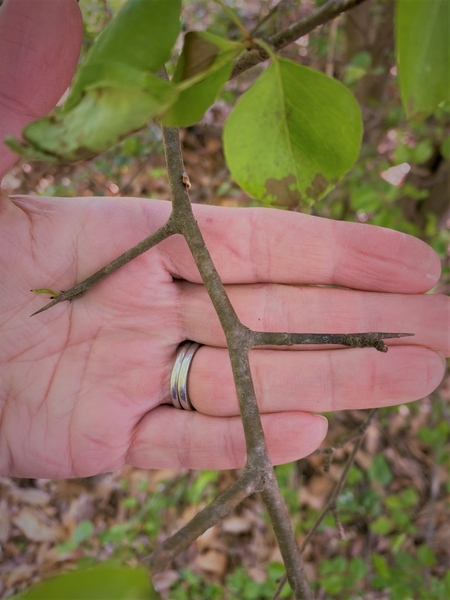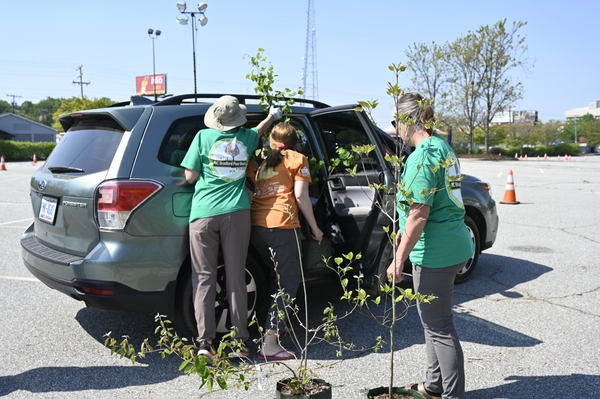Introduction
Callery pear (Pyrus calleryana Decne.) is an Asian species of ornamental pear with several cultivars planted throughout the Southeast. Varieties include ‘Bradford’, ‘Chanticleer’/‘Cleveland Select’, ‘Autumn Blaze’, ‘Aristocrat’, and more. Ornamental plantings of Callery pear are gaining increased scrutiny in recent years as evidence and impacts of its invasiveness mount. Once prized ornamental trees, ‘Bradford’ and other varieties of P. calleryana are an increasing environmental and land management concern.
History of the ‘Bradford’ Pear in the US
Pyrus calleryana was first introduced into the United States in the early 1900s to breed resistance to fire blight (a fungal disease) in fruit-producing European pear trees (Pyrus communis). Soon after, it was discovered that the tree had potential as an ornamental and grafted individuals were created. The first variety was the ‘Bradford’ pear (Pyrus calleryana ‘Bradford’), first cultivated in the 1950s and prized for its white blossoms in early spring, ability to withstand low-quality soils, and symmetrical oval-shaped canopy. It is almost entirely pest-free and considered “low-maintenance” relative to other horticultural selections. 'Bradford' and other varieties of Callery pear were a preferred selection for plantings from the 1960s through the 1990s. They were planted widely, becoming one of the most common urban trees in the southeastern United States.
However, while the tree looked idyllic, many were quick to notice the pungent odor associated with the flowers. Attributed to chemicals emitted to attract pollinators, it has been likened with rotting fish and other unsavory odors. Moreover, the tree’s acute branching structure and fast growth lead to weak branch unions. Eventually, the tree can break under its own weight and mild or moderate storms cause excessive branch and main stem breakage, leaving a mess and in the worst cases, injury or property damage.
These issues as a landscape tree aside, it is the tree’s invasion into native ecosystems that is of primary concern.
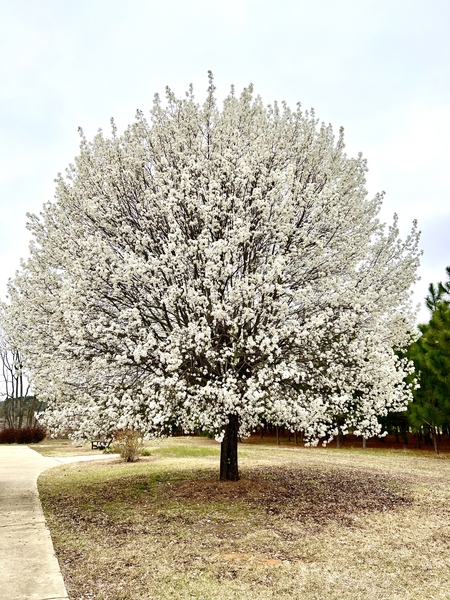
The 'Bradford' pear is prized for its white flowers that appear in early spring.
Kelly Oten CC BY 4.0
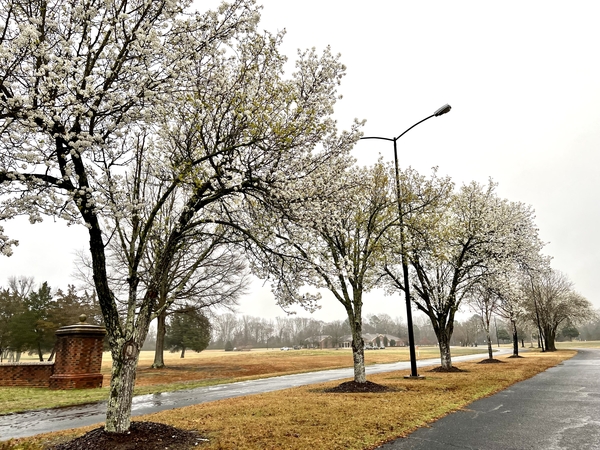
'Bradford' and other varieties of Callery pear are often planted in rows at poor sites because they thrive in many conditions.
Kelly Oten CC BY 4.0
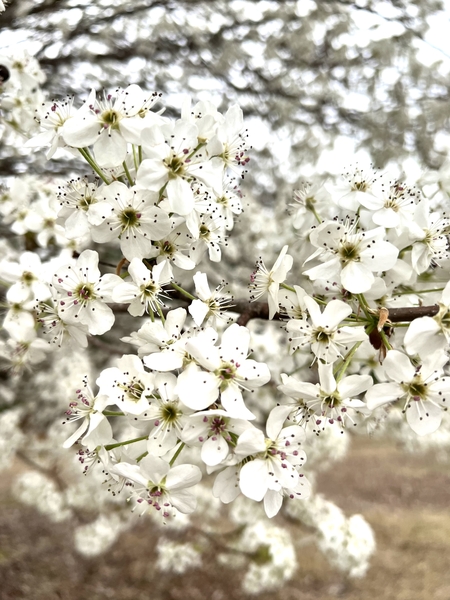
The showy white flowers of the 'Bradford' and other varieties of Callery pear are some of the first to appear each spring.
Kelly Oten CC BY 4.0
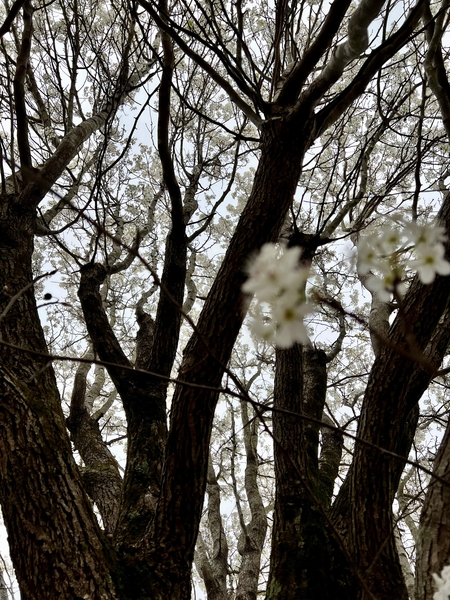
'Bradford' pear's acute branching structure contributes to weak branch unions which break easily in storms.
Kelly Oten CC BY 4.0
"Wild" Callery Pear: The Invasive Offspring
When the 'Bradford' cultivar was first introduced, it was touted as sterile. The tree is unable to self-pollinate, and since each specimen are grafted trees with genetically identical upper portions, it is unable to be pollinated by other ‘Bradford’ pears. However, when new cultivars of P. calleryana were developed (e.g., ‘Chanticleer’/‘Cleveland Select’, ‘Autumn Blaze’, ‘Aristocrat’) and planted or when shoots grow from 'Bradford's Callery pear rootstock, successful cross-pollination is possible, offering varieties of P. calleryana a pathway to creating viable seed. This seed, when consumed by birds and other vertebrates and defecated elsewhere, give rise to invasive offspring. “Wild” Callery pear infiltrate roadsides, agricultural fields, unmanaged lots, and forests. They are easily spotted in each spring due to their early-blooming white flowers and increasing prevalence.
The invasive Callery pear has wide-ranging impacts on our ecosystems. Callery pear’s hardiness makes it an adept invader, taking over fields and forested areas across the eastern United States. Because these trees flower and produce leaves early in the spring, before most native plants, they can shade out and displace native flora. They are capable of forming dense thickets, resulting in little to no understory and in many cases, bare ground. Recent research suggests herbivores feed less on Callery pear than they do on native tree species, meaning fewer enemies to help manage callery pear. Moreover, in Callery pear thickets, there is decreased food available to wildlife like birds, who depend on foliage-feeding caterpillars.
"Wild" Callery pear is also creating significant land management obstacles. Unlike their parent trees, the wild progeny have large thorns, reaching up to four inches in length. When these trees form thorny thickets, this can prevent wildlife from moving through forests and from using trees as cover. Additionally, thorns can pop the tires of large equipment, posing challenges for land managers trying to remove Callery pear to use their land for agricultural purposes or to clear out the understory in pine plantations. Land managers must either hand remove Callery pear or use expensive steel-tracked equipment.
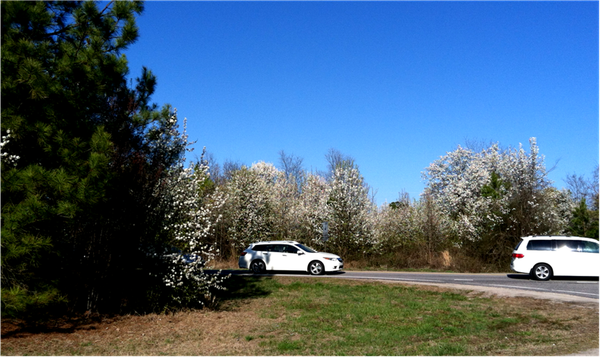
Callery pears are prominent along roadsides. Their white, showy flowers are hard to miss each spring.
Kelly Oten CC BY 4.0
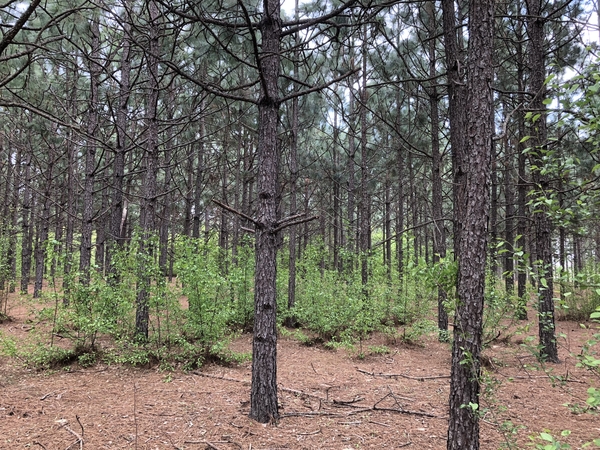
Callery pear also invades forest understories. Each of these green trees are the "wild" progeny.
David Coyle, Clemson University. CC BY 4.0
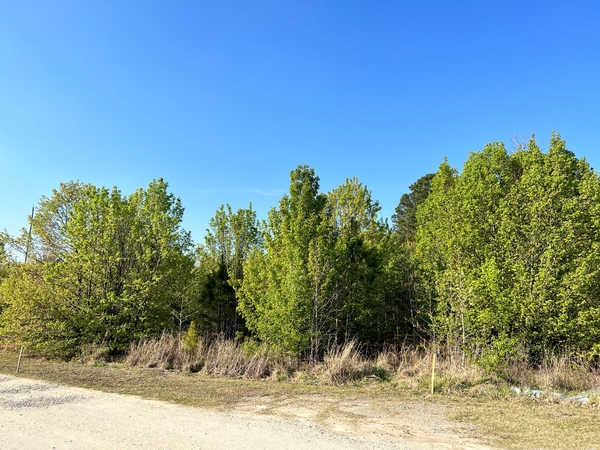
Old agricultural fields are perfect areas for Callery pear to infest, displacing natives and creating land management issues.
Kelly Oten CC BY 4.0
Regulations Preventing the Sale and Plantings of Pyrus calleryana
Due to the expensive ecological and land management problems Callery pear creates, several states have banned the planting and sale of all varieties of Pyrus calleryana. The ban will be enforced by 2024 in South Carolina and Pennsylvania and by 2023 in Ohio. While it will not be illegal for homeowners to have existing 'Bradford' or other varieties of Callery pear in their landscapes, it will be illegal for the tree to be sold or planted.
Public Awareness and "Bradford Pear Bounties"
The increasing appearance of local and national news articles raises awareness of the invasiveness of 'Bradford'/Callery pear (e.g., recent articles in the New York Times, Washington Post, and USA Today).
Additionally, several states, such as North Carolina, South Carolina, Kentucky, and Indiana, have launched “bounties” against the Callery pear. These programs allow homeowners to receive free native trees in return for removing 'Bradford' or other planted Callery pears from their property. In North Carolina, organizers include NC State Extension, NC Urban Forest Council, NC Wildlife Federation, and NC Forest Service. North Carolina's inaugural event occurred in Greensboro, NC on April 23, 2022.

North Carolina's Bradford Pear Bounty offers free, native replacement trees to those that remove 'Bradford' or other ornamental varieties of P. calleryana from their property. Here, a volunteer with the N.C. Forest Service carries a replacement tree to a program participant.
Shea Phillips CC BY 4.0
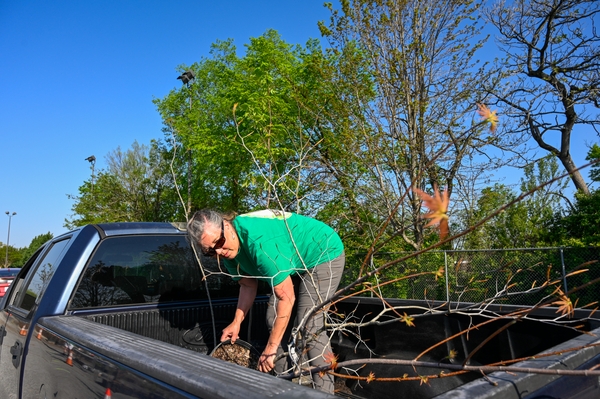
A volunteer load native trees into a participant's truck at the inaugural Bradford Pear Bounty in North Carolina.
Shea Phillips CC BY 4.0

A Bradford Pear Bounty participant signs in. Participants must pre-register and show photographic proof of P. calleryana removal.
Shea Phillips CC BY 4.0
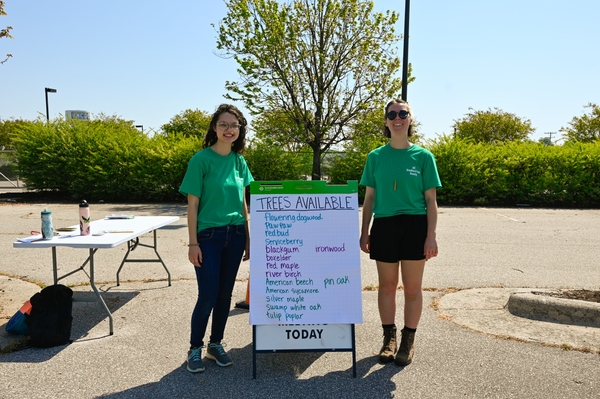
Bradford Pear Bounty participants are able to choose their replacement tree from a list of natives.
Shea Phillips CC BY 4.0
What Should You Do?
Landowners with any variety of P. calleryana on their property are encouraged to remove or replace them to reduce continued spread. Fortunately, there are many beneficial trees native to North Carolina that have similar aesthetic value as the 'Bradford'/Callery pear. Examples include flowering dogwood (Benthamidia florida), eastern redbud (Cercis canadensis), serviceberry (Amelanchier spp.), black cherry (Prunus serotina), or Chickasaw plum (Prunus angustifolia).
Removal
Callery pear removal can be difficult due to its large thorns and dense growth habits. Smaller plants may be removed by hand, but all roots must be removed to prevent resprouting. It is strongly recommended to treat stumps with herbicide after cutting to prevent resprouting.
Basal bark sprays or foliar sprays can be used for smaller Callery pear trees using triclopyr or glyphosate. Larger trees may be treated with basal bark sprays, the hack-and-squirt method, or the cut stump method. Vogt et al. (2020) studied the efficacy of herbicide treatments against P. calleryana in Georgia and South Carolina. They tested basal bark applications, foliar applications, and soil application. While soil application of hexazinone failed at one site (perhaps due to inadequate rainfall), the foliar sprays (using imazapyr and glyphosate) and basal bark sprays (using triclopyr and a combination of triclopyr with aminopyralid) consistently controlled Callery pear.
Callery pear is persistent, so monitoring is often required to ensure that resprouting does not occur. Reinvasion may occur, requiring more removal and treatment.
References
Culley, T. M., & Hardiman, N. A. (2007). The beginning of a new invasive plant: A history of the ornamental Callery pear in the United States. BioScience, 57(11), 956–964.
Hartshorn, J. A., Palmer, J. F., & Coyle, D. R. (2022). Into the wild: Evidence for the enemy release hypothesis in the invasive Callery pear (Pyrus calleryana) (Rosales: Rosaceae). Environmental Entomology, 51(1), 216–221.
Vogt, J. T., Coyle, D. R., Jenkins, D., Barnes, C., Crowe, C., Horn, S., Bates, C., & Roesch, F. A. (2020). Efficacy of five herbicide treatments for control of Pyrus calleryana. Invasive Plant Science and Management, 13(4), 252–257.
Publication date: May 13, 2022
N.C. Cooperative Extension prohibits discrimination and harassment regardless of age, color, disability, family and marital status, gender identity, national origin, political beliefs, race, religion, sex (including pregnancy), sexual orientation and veteran status.

